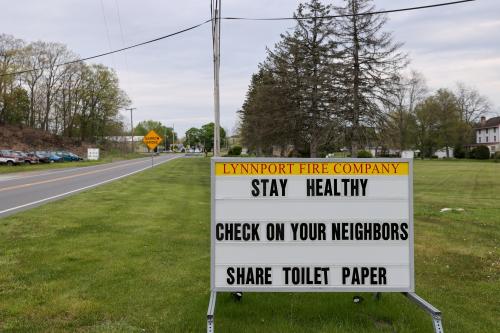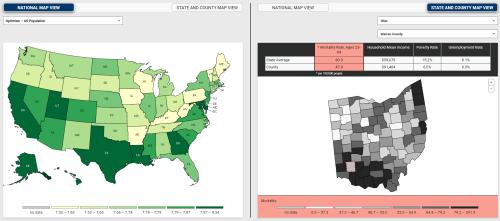The drawbacks of Europe’s rapidly aging population have become even more visible over the last month as the global COVID-19 pandemic has swept through the region. In some places, the sudden burden of disease has led even to the rationing of access to intensive care, creating nightmares for health providers and the families of the afflicted. Epidemics will undoubtedly happen again, but could we reduce the suffering and death in groups that are especially susceptible to communicable diseases? Could the vulnerability of older demographic groups to specific health threats be anticipated and planned for, especially in cities where this pandemic is unfolding in full force and future outbreaks are likely to strike again?
We think the answer to these questions is yes. Using a new dataset called AgeSpot—pioneered by World Data Lab and GeoVille Information Systems and Data Processing—it is now possible to explore the changing age profile of cities over time, and assess the preparedness of neighborhoods to meet the various health, education, and mobility needs of their residents, current and future. With the recent rollout of COVID-19 lockdown measures across the United Kingdom, we can provide insights into London’s age structure today and tomorrow by exploring patterns under a magnifying glass. We do this by city block (50 x 50 m2 level); for the purposes of policy analysis, these data are then aggregated at the ward and district levels.
The data projection engine works with a fuel that blends satellite imagery, information from OpenStreetMap, and the latest census data. The team first calculated population densities at the grid level with geospatial images. Then these population density projections are combined with census data where the grid is overlaid with key infrastructure and institutions such as hospitals and universities from OpenStreetMap. This allows us to calculate relationships between age cohorts and these places of interest. Building on the current age structure and expected structural shifts (e.g., in education levels), the team modeled London 2030 using a Bayesian model averaging approach to estimate the number of people and their age for each city block in London. This is what we found.
1. Seniors are concentrated in central London
The areas of London with the highest density of residents over the age of 65 are in the heart of Greater London, including Kensington and Chelsea, Islington, Camden, and Westminster (Figures 1 and 2).
The model projects that London’s senior population will grow by 13 percent over the next 10 years, with the largest growth expected in Camden where seniors would increase by almost 30 percent (that is, by about 8,500 people). Camden, Barnet, and Croydon are expected to see the largest absolute increases. Local authorities should expect the pressure on health care resources in these wards to grow, as older populations need more health care services on average. Indeed, in most districts of London, growth rates for this age group are expected to reach double digits—ranging roughly between 10 and 20 percent. The notable exceptions are Barking and Dagenham, which are expected to see a decrease of 8 percent.
Figure 1. The Elderly are concentrated in Greater London’s center

Figure 2. Central London will maintain its high senior density during the next decade

2. The density of children will grow in Barking and Dagenham
Like other cities around the world, London also needs to plan for the needs—both medical and social-service-related—of other age groups, especially children. The demand for schools, day care facilities, parks, and playgrounds will also have to be anticipated, and facilities constructed to accommodate the growing density of children in the city. Barking and Dagenham will see one of the largest increases in children aged zero to 15 of all the districts with a population of over 60,000 people. The number of children in this district is expected to increase by 15,000 to 76,000 by 2030, with the largest increase in children anticipated in the Thames ward (39 percent) and the smallest in Eastbrook (5 percent).
3. Young adults will see the smallest growth
Finally, despite the traditional lure of urban areas to young adults (aged 16 to 30 years), this group is expected to register a decrease in population density across many districts in London. Kensington and Chelsea will likely see young adult populations drop by one-third (about 9,000 people), specifically in the wards of Campden (-74 percent) and Pembridge (-64 percent). The district of Hammersmith and Fulham is also expected to see a drop of around 20 percent (8,000). Drops between 10 and 20 percent are expected in the districts of Ealing, Merton, Richard upon Thames, Wandsworth, and Westminster. City administrators and businesses will have to plan accordingly.
Like others, we have been monitoring the COVID-19 statistics being published every day by Johns Hopkins University and others. What is becoming clear is that to fight this disease and future epidemics more effectively, cities have to better understand their vulnerabilities. Anticipating what might happen tomorrow seems impossible during these uncertain times, but algorithms informed by the flow of information generated by economic shifts and demographic momentum that only massive computational power can properly analyze, make seeing beyond the horizon possible. Given the growing ease of making these projections, it is becoming irresponsible not to use them to make policy.
Note: For questions regarding the underlying data and methodology, please contact Kristofer Hamel ([email protected]). We thank Wolfgang Fengler for his inputs and review.










Commentary
Using big data to assess London’s vulnerabilities and vitality
April 8, 2020